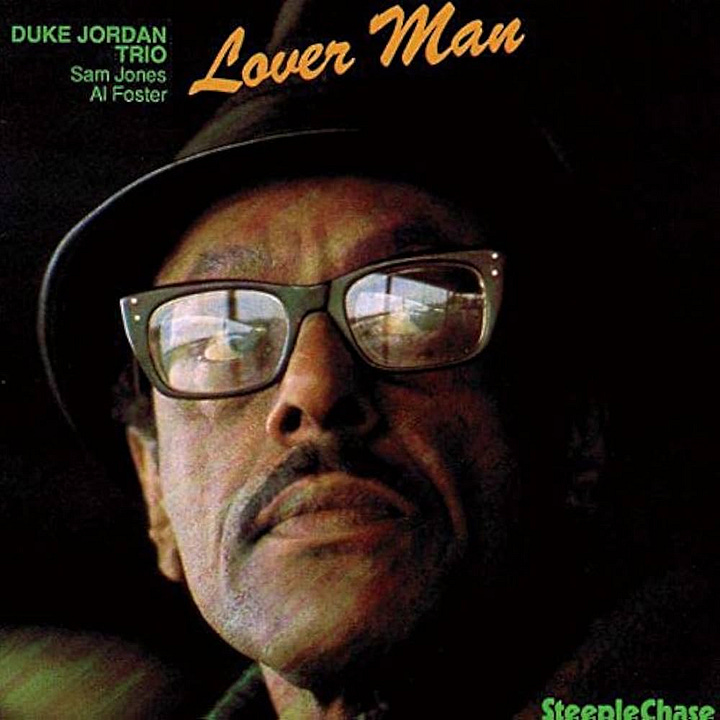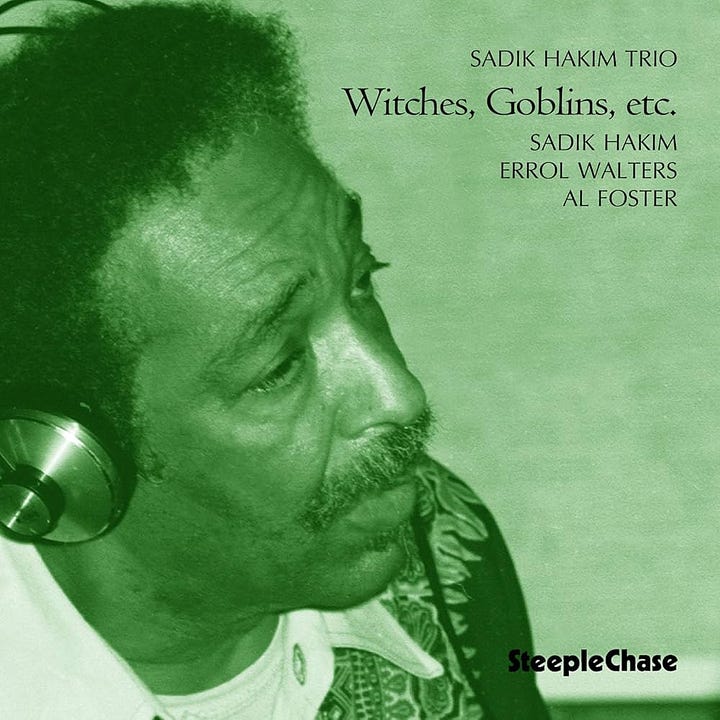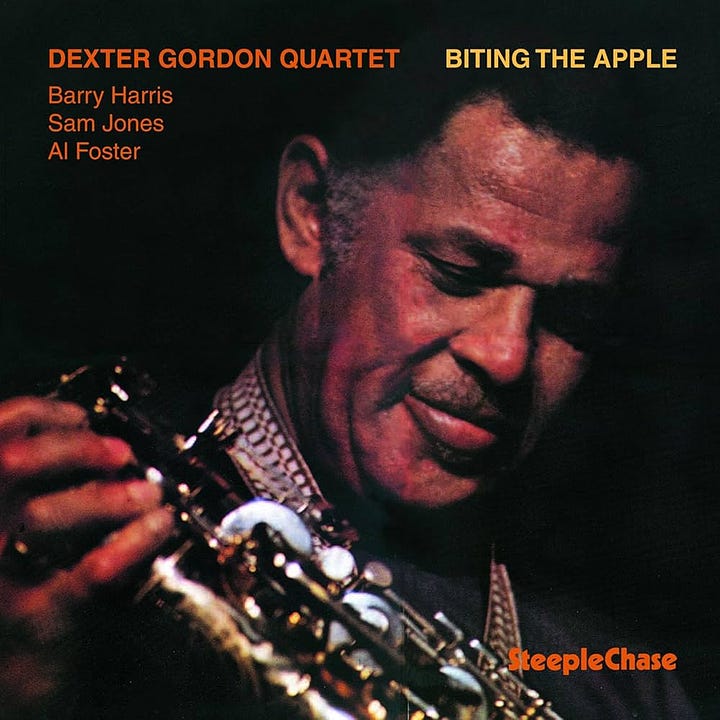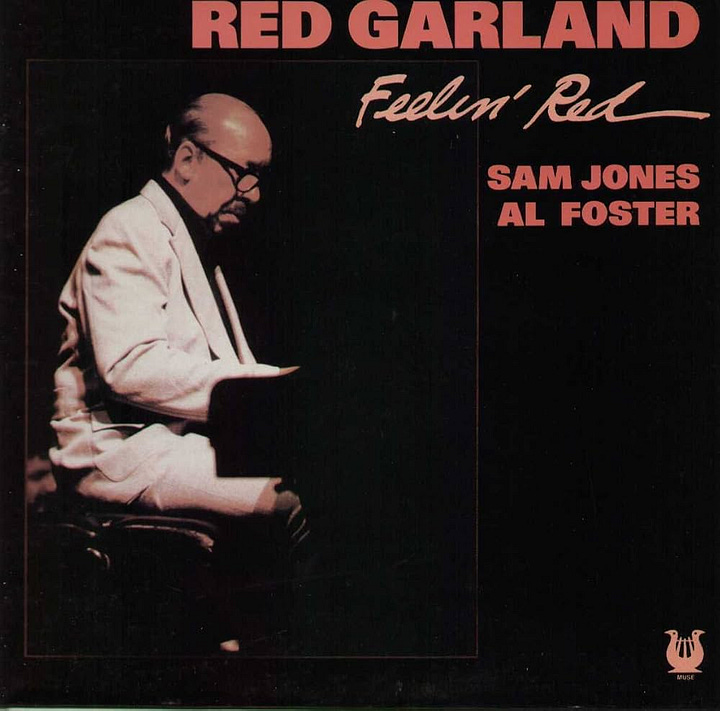When drummer Al Foster was with Miles Davis in the Seventies1, Davis’s music sounded nothing like jazz. Instead of songs and solos, Miles, in chronic pain, poor health2, and fighting drug dependence, would direct his band through lengthy, guitar-centric, one-chord jams3.
From my position, a few million light years away from the inner circle, Al Foster is Davis’s port in the storm, the person Miles could rely on. Al’s unimpeachable musicianship, taste, and humility— playing simple, clear funk/rock beats with detail, nuance, and heart, selflessly giving Miles what Miles needed— is the only consistently satisfying part of Davis’s music from this era (Miles himself, after all, was so unstable that he often struggled to play). But Al sounds great, no matter what.
While Miles’s Seventies records don’t sound like jazz, the more I listened, the more I heard how Foster’s tasty, musical backbeats come from Al’s mastery of straight-ahead jazz drumming.
Listen to the opening of Davis’s Agharta, recorded in 1975. Foster plays a supple and swinging two-bar rock/funk beat, letting the music simmer, and holding the band together. That’s a jazz drummer. When Miles starts at about 2:29, Foster responds, builds the energy up, keeps the band together, and follows Miles. That’s a straight-ahead jazz drummer.
Which means Al Foster understood Miles in a way that few around Davis could or did. In Al’s tenure with Miles in the Seventies, Foster was the only one with long experience playing hard-core, straight-ahead jazz4. Alone in Miles’s band, Al Foster could really play bebop.
I keep thinking about Miles hearing Al’s swinging ride cymbal at the Cellar in 1972. No matter that Miles hadn’t played anything with a swinging ride cymbal in years, Davis understood Al perfectly, as a premier young drummer in the style, and of the community, from which Miles himself emerged, thirty years ago.
While Miles, isolated5 and fighting to keep ahead of dependence and depression, made music that existed only in a tenuous present, Al Foster was a bridge to Davis’s musical past.




Sick and suffering, Miles Davis finally went on hiatus in the fall of 1975. Al Foster was now at liberty, and bebop— the music that brought Miles and Al together— was in the air. Soon, Foster was making new records in NYC with some of real bebop legends, folks who maybe hadn’t recorded in years, or been living abroad, or both. But they’d been there all along, doing what they do, keeping it going6.
After the glamorous and seductively repetitive music of Davis’s On The Corner era, it was a breath of fresh air to hear these lovely, open-hearted, high quality straight-ahead records featuring Al Foster. Fittingly, they speak of things that Miles’s own music with Foster does not.
None of these albums are well-known, and all are by artists (save Gordon) who were never in the limelight. As a young man, music like this sounded good but seemed inessential. As a middle-aged man, it speaks loud and clear, feels written in my soul. I just love these records.
Playlist for all the tracks is here, or click on individual songs:
Duke Jordan: “Dancer’s Call” (Jordan) from Lover Man (SteepleChase, 1975). We’re now back at the medium tempo of Blue Mitchell’s “Step Lightly” for a lovely, Basie-like groove from Jordan, bassist Sam Jones, and Foster. 10 years after The Thing To Do, Al has his own sound, his own beat, and his own unmistakable presence.
Dexter Gordon: “Apple Jump” (Gordon) from Biting The Apple (SteepleChase, 1976). From the first second I hear this, I want to yell “Alright!”. Foster plays an infectious, gentle backbeat, hand-in-glove with the great Sam Jones, behind Gordon’s first chorus, and even for pianist Barry Harris. Is there another Harris solo with a straight-up backbeat in 4/4 swing? Pay attention to Foster when he lets the backbeat go for during Harris’s solo: his signature quarter-note triplets and wandering left hand feat neatly inside Harris’s pure bebop. This shows Foster’s profound mastery— he gets bebop, both technically and emotionally, and has found his own way to do it. This is supreme mastery.
Dexter Gordon: “A La Modal” (Gordon) from Biting The Apple (SteepleChase, 1976). The atmosphere is charged— Gordon is lighting it up, Foster’s beat is irresistible. Al is the perfect drummer for Dexter and pianist Barry Harris to toe-dip in modal jazz; modal jazz is part of Foster’s generation.
Sadik Hakim: “Say What You Mean” (Hakim) from Witches, Goblins, Etc. (SteepleChase, 1977). I didn’t know that the seldom-heard Hakim (pianist on the original Charlie Parker “Billie’s Bounce” and “Anthropology”) wrote music, much less that he’d made a lovely SteepleChase album of his own compositions. Foster’s right at home, and the Art Taylor influence on his cymbal beat is loud and clear. During the trades, we can savor his muscular Max Roach/general bebop ideas and a few two-handed Tonyisms on the four-piece kit.
Art Pepper: “Straight No Chaser” (Monk) from New York Album (Galaxy, 1979). A great session, Pepper with Hank Jones, Ron Carter, and Foster. Foster’s M.O. is becoming apparent— straight-ahead, but all options are on the table. Foster’s rapidly developing personal vocabulary is ultimately a spur to creativity, perfectly suited to this session.
Red Garland: “It’s All Right With Me” (Cole Porter) from Feelin’ Red (Muse, 1979). A great Garland date with a smoking Al Foster performance (“On A Clear Day” and “Cherokee”), and the third album on our list pairing Foster with Sam Jones. “It’s All Right With Me” features some of the most lyrical cymbal playing from Foster in this era— Jones’s walking solo with Foster on the cymbal is poetry. This is a full-circle moment, Foster playing with the pianist who told Miles Davis what ballads to play. Only Al Foster could play with both Miles in the Seventies and Red Garland in the Seventies.
After these and other high-level straight-ahead recordings7, Foster was ready to take his place at the music’s cutting edge. Musicians took notice and invited Al to participate in some significant recordings of new music:
Sam Jones: “Occurrence” (Tom Harrell) from Visitation (SteepleChase, 1979). With trumpeter Terumasa Hino, Bob Berg on tenor, plus pianist Ronnie Matthews, this Jones quintet playing a Tom Harrell tune is still what I think of as “NYC jazz”, even though this kind of music is seldom heard today. Al’s nailing the arrangement and hooking up the soloists, clear and adventurous. We haven’t heard Foster on a session like this yet.
Freddie Hubbard: “Santa Anna Winds” (Hubbard) from Outpost (Enja, 1981). Hubbard with Foster, Kenny Barron and Buster Williams. Al sounds just so great here. Everything he plays fits— every cymbal crash and tom fill means something and propels the music forward. I wish Hubbard had made ten albums with this quartet.
Joanne Brackeen: “Estilo Magnifico” (Brackeen) from Fi-Fi Goes To Heaven (Concord, 1987). Composer Joanne Brackeen has a completely individual conception and the drama of a concert pianist— I should study her music. Foster is right at home with her asymmetrical theme, and grounds the soloists (Brackeen, plus a young Terrence Blanchard and Branford on alto!) while giving them plenty of room.
Buster Williams: “Decepticon” (Williams) from Something More (In+Out, 1989). A very special snapshot of Buster and Al Foster with Herbie Hancock and Wayne Shorter, plus trumpeter Shunzo Ohno. The whole date is extraordinary, but “Decepticon” is the one we’ve been waiting for. Not overshadowed by Tony, Jack, or any of the other giants Foster revered, Al is himself, at ease, playing beautiful time, letting the music happen. What a joy to hear him answer Shorter’s questions and pick his spots with Herbie and Buster. Playing medium-up 4/4 swing with Wayne, Herbie, and Buster (at Van Gelder’s, no less), Al Foster is right where he belongs, the place he’d worked to get to. Bravo!
I’m starting to get it: Joe Henderson brought it all together. He’s the tenor soloist who, on a blues, ballad, standard, or bebop tune, brought all the disparate strands of the music together into a beautiful, awe-inspiring whole, a hero who stayed active for decades, singing his song for us. When Henderson teamed up with Al Foster, one of the all-time great partnerships was formed.
Joe Henderson: “Friday The Thirteenth” (Monk) from State of the Tenor (Blue Note, 1985). Perhaps the first hint we get of the deepening Joe Henderson-Al Foster chemistry. Over Monk’s 4-bar form, Joe lights out for the territory. Foster, swinging and armed with his personal bebop vocabulary, rides right alongside.
Joe Henderson: “Cheryl” (Charlie Parker) from State of the Tenor. When Al interjects into Joe’s solo, or plays contrapuntally, we’re hearing the truth. Henderson played with marvelous drummers, but he shared something special with Foster.
Joe Henderson: “Ask Me Now” (Monk), from An Evening With Joe Henderson (Red Records, 1988). As Ethan Iverson points out, when we play “Ask Me Now”, it’s Joe and Al’s conception of the tune we’re playing. Foster shows that a ballad can be a vehicle for high-energy dialogue too.
Joe Henderson: “Serenity” (Henderson), from An Evening With Joe Henderson. See this post.
Joe Henderson: “Take The ‘A’ Train” (Strayhorn), from The Standard Joe (Red Records, 1991). Less intense than An Evening With, here’s Strayhorn’s beloved theme reimagined as a blank slate for the Henderson/Foster connection. With the great bassist/composer Rufus Reid, some of the glamour of the Strayhorn/Ellington original shines through as Henderson and Foster ebb and flow in tandem. And I just love Al’s quasi-double-stroke roll on the hi-hat at the intro, like a blurred Jo Jones.
Joe Henderson: “Milestones” (John Lewis) from So Near, So Far (Verve, 1993). Foster’s swinging so gorgeously, here, just a smidge behind the beat, creating just the right energy for Joe and the band to be free. And it leads perfectly to…
Joe Henderson: “Miles Ahead” (Davis/Gil Evans) from So Near So Far. Henderson, John Scofield, Dave Holland, and Foster render the Don Sickler-arranged Davis-Evans theme so magically that it feels like a collective memory of Miles Davis. Henderson’s two-and-a-half choruses are a perfect natural arc; the ending, with Joe hanging over, is magic. A welcoming piece of music, chock full of jazz action, just four and-a-half minutes long, it could have been a Top 40 instrumental hit. Here, Joe Henderson, John Scofield, Dave Holland, and Al Foster subsume both the complexity and enormous contribution of Miles Davis into a brief and beautiful performance.
Joe Henderson: “Step Lightly” (Henderson) from Big Band (Verve, 1996). A coda: Henderson, Foster, and Chick Corea, the three of them recording together for the first and only time, playing on the tune that began their collaboration. Just as he did with Illinois Jacquet in 1970, Foster’s making the hits and setting up the band, a perfect big band drummer, and lovely to hear Al dance with Joe one last time. A full-circle track, an emotional and fitting closer.
“Step Lightly” was the final recording Foster made with Henderson, though they toured together for a few more years. Henderson stopped recording in 1997, and died in 2001. It marked the end of something for Foster, but for a musician of Foster’s brilliance, it meant the beginning of something else. The next post will look at Al Foster’s recordings as a leader and co-leader.
As chaos threatens to close in, we persist.
If anything can pull out us out of this, it’s people and ideas— the only things worth loving.
Modest as all this is, there is a way forward here. The great Al Foster and his wonderful colleagues point us to a world of people and ideas; of ways to be; of things to love.
Foster first shows up in the Davis discography in July 1972, and is with him continuously until Davis’s hiatus in the fall of 1975. When Davis reemerged in 1981, Foster was there. Al left Miles’s band for good in 1985. Davis and Foster’s final recording together, Marcus Miller’s “Mr. Pastorius”, from Amandla, features Miles with an open horn soloing over Miller and Foster’s 4/4 swing, just marvelous. Finally, there’s the Miles Davis retrospective concert in France on July 10, 1991, where Miles and Al performed together one last time.
Davis’s October 9th, 1972 car accident on Manhattan’s West Side Highway, when he totaled his car, broke both ankles, and was forced to cancel all gigs for the fall, seems to have kicked off a particularly hard time. In February ‘73, Miles made the tabloids when the NYPD were called to his home for a domestic dispute (Szwed, 335). A year later, while on tour in Brazil with a bleeding ulcer, Miles suffered a heart attack (Szwed, 339). In late ‘74, Pete Cosey called Davis’s son Gregory to inform him that Miles had been beaten by a drug dealer (Szwed, 341) and now needed protection. Finally, Davis was suffering from walking pneumonia during the Japanese tour of 1975 (Szwed, 342), where two shows in Osaka on February 1st were released as Agharta and Pangaea.
Sometimes there are other things— “Honky Tonk” is I-IV in the key of Eb; “Ife”, originally, was a bass line that outlines Ab (two beats) then Bb (two beats), but when played live it was often just one chord; “Mayisha” is an 8-bar form, but not consistently maintained; et cetera.
No musician in Miles’s touring bands from ‘72 to ‘75 had a background in bebop and hard bop except Al Foster, including Dave Liebman (who was playing some of the best modal jazz ever recorded with the great Elvin Jones prior to joining Miles) and Sonny Fortune (full-blast modal celebrations with McCoy Tyner, and slick, excellent versions of “Chameleon” and “Nica’s Dream” with Buddy Rich). The only exception might be Panamanian saxophonist Carlos Garnett (1938-2022), who had played with Freddie Hubbard and Art Blakey before joining Davis. But Garnett was only with Davis for from June to December 1972, whereas Foster was a presence in Miles life and music from ‘72 til Davis’s death in 1991.
I keep reading around, and listening, and trying to understand, and it keeps coming back to: Al Foster was there, Al Foster knew what Miles could really do, musically, and Miles knew that Al Foster knew. Hence, “Mr. Pastorius”, Miles’s gift to Al Foster.
A final Szwed quote from page 341: “Nobody comes to see me. None of the guys, you know. All the young guys do but Thad [Jones] and all my friends like that never do. I like them but they don’t like me. Dizzy asks me to teach him. I say ‘yeah, come by, I’ll show you everything we’re doin’. It’ll be my pleasure.’ And he don’t come by.”— Miles Davis to Sy Johnson in 1974, published 1976, quoted in John Szwed’s So What: The Life Of Miles Davis (2002). Thank you Lewis Porter for steering me to this helpful guide to Davis’s labyrinthine life!
On the surface, Dexter’s Biting The Apple and Red Garland’s Feelin’ Red are light years away from Miles’s Big Fun and Get Up With It, but all the folks Foster was recording with had a connection to Miles. Sadik Hakim was on Miles’s first jazz recording session for Savoy with Charlie Parker in November 1945; Duke Jordan was the pianist in the 1948 Charlie Parker quintet with Miles, the group called by some, according to Phil Schaap, the “Golden Era Bebop 5”; In 1957, Art Pepper hired Davis’s rhythm section of Philly Joe Jones, Paul Chambers, and Red Garland, for his first record date after a prison sentence; Dexter Gordon was Davis’s colleague in Benny Carter’s band, the man who piqued Miles’s fashion interest; and Red Garland, three years Miles’s senior, was of course the pianist in Davis’s own quintet! From 1976 to 1979, Al Foster was recording with the scene that produced Miles Davis.
Al Foster also played on three Aebersold play-a-longs that have been widely used since they were released in 1978: Dave Liebman (Vol. 19) and Horace Silver (Vols. 17 and 18). Indeed, these are among the Foster performances jazz musicians know best, and are an important part of the story of jazz at this time.




Excellent words as always, Vinnie. You listen so deeply. I imagine that like me, other readers are going back to listen deeper into the albums mentioned in your essay. Keep on keeping on!
Great!